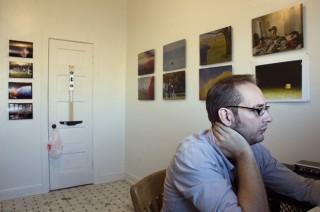Painter to filmmaker

October 19, 2008
Raised on working-class principles prevalent in Pittsburgh, Steven Summers spent his time drawing and painting in the Steel City, which boasts a history of artists like pop art prince Andy Warhol and impressionist painter Mary Cassatt.
Now that Summers has found himself in Chicago, a few hundred miles from home, he is making a name for himself in a medium far from his drawing roots-film and video installation-by being one of the featured artists in this year’s Chicago Artists Month.
Summers first moved to Chicago six years ago for graduate school at the School of the Art Institute of Chicago. His piece is not a film, but a series of stills that he has been working on for about a year.
The stills are single frames that have been extracted from video he’s shot over the years, he calls it “extracted narratives.”
“What I was interested in was how traditional photography contains a narrative within itself-you can get certain information from it, and it’s supposed to point you down a certain path,” Summers said. “I’m trying to explore an idea of [isolation].”
The stills from the various videos that Summers shot were not consistent with one collective and cohesive idea or object. After extracting the stills, those photos were then printed on aluminum to give them a glow, he said.
“I think it’s an interesting use of material-printing on metal for photography,” said Angela Mobley, who graduated with Summers in 2005 from the School of the Art Institute of Chicago. “I’m a photographer, so I was interested [in him] printing them on metal.
They have a different read than if they were prints on paper, [which] worked for the type of images [he was] using.”
The use of film, Summers said, gives him the ability to freely express his ideas. He said he tries to find an idea worth exploring, plays with it and sees what happens.
Owen Smith, the exhibitions coordinator at the Mattress Factory-an installations art gallery in Pittsburgh where Summers worked before moving to Chicago-said a lot of Summers’ earlier work explores personal relationships with people.
“He used to film friends in their houses falling, and just before they hit the ground he would cut to another person doing the same thing,” Smith said. “It was a never-ending loop.”
Time is used in his videos as a reoccurring theme, as well as death and memory, choosing to deal with a more human aspect of issues everyone can relate to.
“Film helps me work through personal stuff and keeps me busy,” Summers said. “I’ve been doing it for so long that it is the best way I can communicate, outside of verbally communicating. “
He initially applied to get his master’s in painting, but when he was denied acceptance into the graduate program, he then turned his sights to new media.
“I wanted to get into film and video for a while,” Summers said. “I [decided to] dedicate myself full-time and found that it was a [form of communication] that I could [be successful] in, more than painting.”
Summers was struggling to keep within the confines of the painting realm.
“I still love painting, but I find that the ability to use the element of time to express myself within video is more conducive to [what] I wanted to do,” Summers said.
Not just a filmmaker, Summers also teaches video and new media at The Chicago Academy for the Arts.
This past summer, Summers helped out as a cameraman on a film with Alexander Stewart, a filmmaker and teacher for the digital cinema program at DePaul.
“His video work is new and interesting,” Stewart said. “He made a leap into video [from painting and fine art], and it’s work that is actually really strong.”
Through his experience in art-talking with artists and teaching students-Summers said he has learned what it means to be an artist.
“There is this illusion of what an artist is-a bohemian that starves himself to death and lives in a closet-but by living and learning [through your art], you can do this, but it’s always going to be a fight.”







